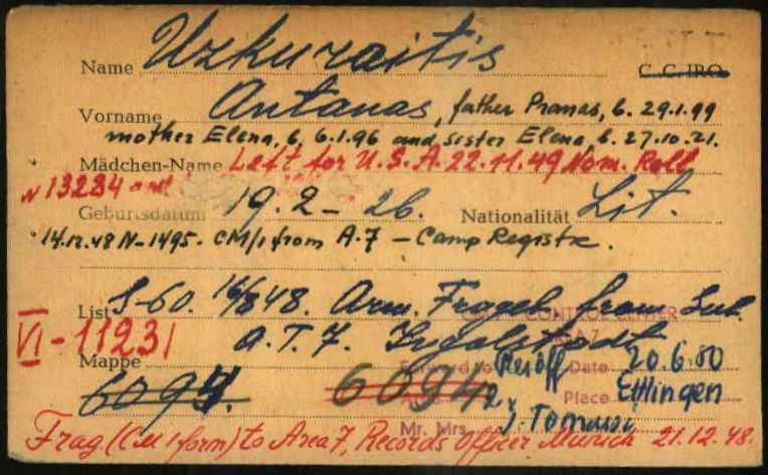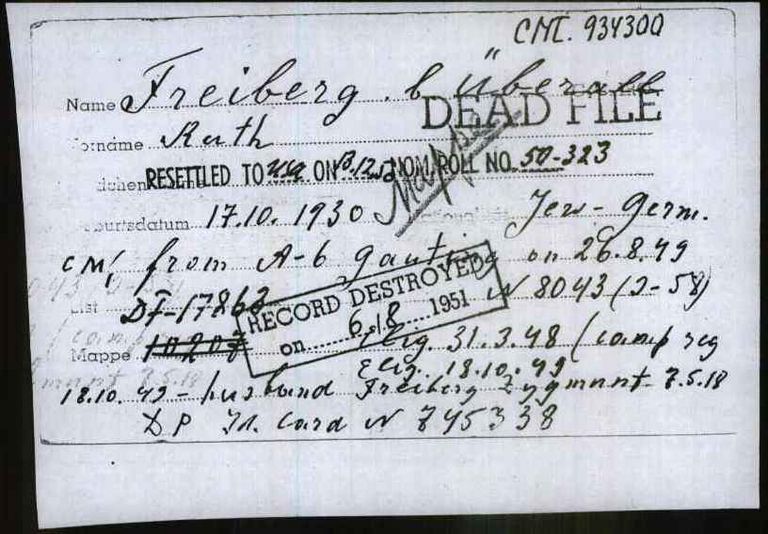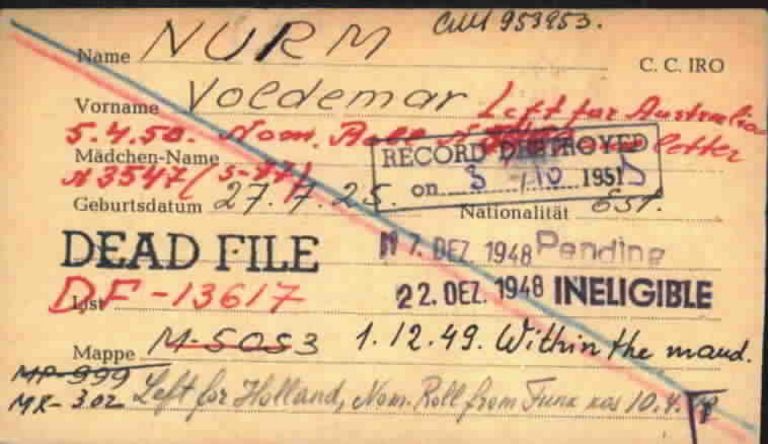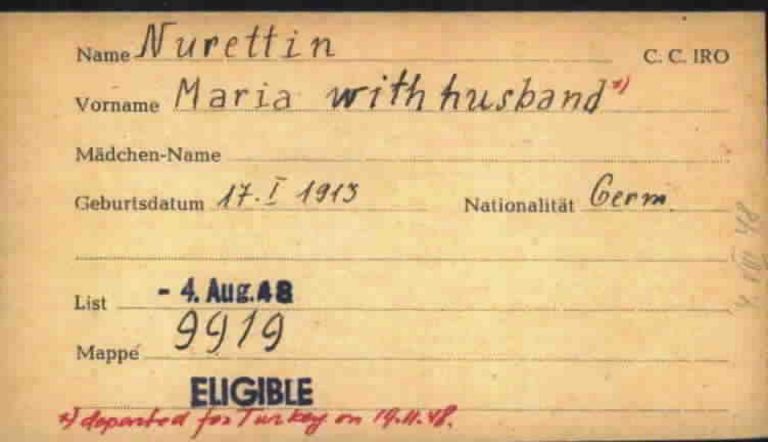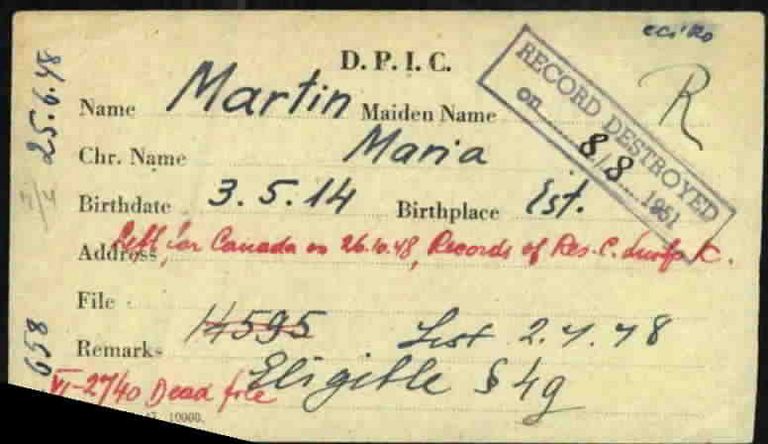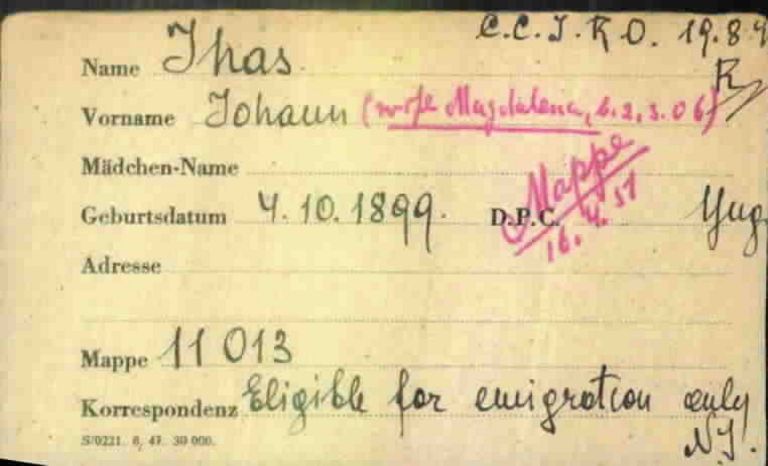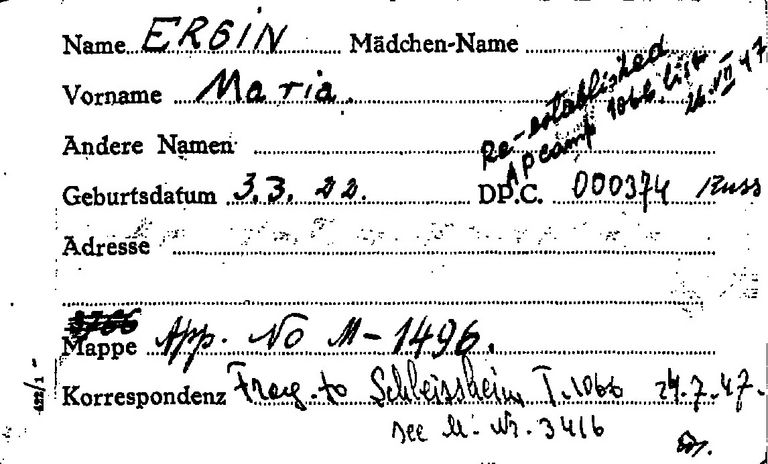Page of
Page/
- Reference
- Intro
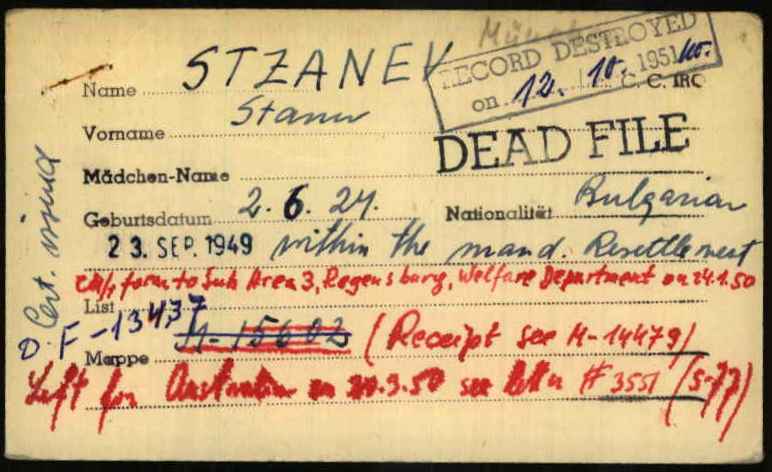

After the IRO started its support program for DPs in July 1947, IRO employees used CM/1 forms to screen applicants for their eligibility. Only then were they recognized as DPs and provided with care. This screening took place in Control Centers (CC). Some of the index cards used there have been preserved in the Arolsen Archives. Unfortunately, it is no longer possible to say whether the individual cards come from a special Control Center. However, the many stamps and comments on the cards make it possible to trace the paths taken by the DPs.
There are different variations of this card, including one in English. The cards are all very similar, however. They can be most easily identified by the last two lines on the card: Mappe and Korrespondenz or List on the German cards, and “File” and “Remarks” on the English cards.
After the IRO started its support program for DPs in July 1947, IRO employees used CM/1 forms to screen applicants for their eligibility. Only then were they recognized as DPs and provided with care. This screening took place in Control Centers (CC). Some of the index cards used there have been preserved in the Arolsen Archives. Unfortunately, it is no longer possible to say whether the individual cards come from a special Control Center. However, the many stamps and comments on the cards make it possible to trace the paths taken by the DPs.
There are different variations of this card, including one in English. The cards are all very similar, however. They can be most easily identified by the last two lines on the card: Mappe and Korrespondenz or List on the German cards, and “File” and “Remarks” on the English cards.
Questions and answers
-
Where was the document used and who created it?
In July 1947, the IRO took over responsibility for providing assistance to the Displaced Persons still living in Germany, Austria and Italy. To ensure that everyday care and emigration support were only provided to people who met the IRO definition of a DP, the IRO thoroughly screened each case. Applicants filled out CM/1 forms which were then used as the basis for interviews with IRO employees. All of the information came together in the IRO Control Centers. To manage this information, the eligibility officers used special index cards, some of which have been preserved in the Arolsen Archives.
All of the cards examined thus far have some connection to Bavaria. They mention DP camps in Pasing, Wildflecken and Ingolstadt as well as the Area Teams in Munich, Regensburg and Würzburg. It can therefore be assumed that the cards were kept in a Control Center in the US occupation zone. Three things confirm that these are IRO documents: first, the abbreviation “C.C.IRO” (Control Center IRO); second, the dates mentioned on the cards, all of which are from the time period that the IRO was responsible for DP support; and third, the fact that all of the information relates to the Care and Maintenance program of the IRO and the emigration of the DPs.
- When was the document used?
The dates and stamps on the cards come from the time period in which the IRO was responsible for caring for the DPs: July 1947 to December 1951. In this period, IRO employees used the cards in the Control Centers. It is not possible to say exactly when the cards were sent to the ITS after the IRO ceased operations, but the date that was stamped on the back of the cards when they were placed in the postwar card file shows when ITS employees began using the cards for tracing inquiries. Most of the cards examined thus far have a stamp from the years 1970 to 1973. However, ITS employees filed some of the cards in the Central Name Index (CNI) in the late 1960s. It has not yet been possible to determine whether or not all of the cards were already in Arolsen at this point and were only gradually filed.
- What was the document used for?
Unfortunately, it is no longer known exactly what the cards were used for by the IRO employees in the Control Centers. However, a great deal of evidence indicates that these were reference cards pointing to letters, forms and other documents that were collected together in a folder for each applicant. On the cards, the employees noted when they had forwarded documents like the CM/1 application, for example, or who they had received the documents from. They also noted precisely when a DP emigrated. They recorded the emigration date, destination country and camps in which the DPs completed their last emigration formalities before departing. The IRO employees also stamped the cards at the end when the file or record was destroyed after the DP had emigrated.
- How common is the document?
The cards must have been very common in the Control Centers of the IRO. Theoretically, there could have been a card like this for every CM/1 application. The Arolsen Archives alone hold CM/1 applications from around 350,000 applicants.
However, it is not known exactly how many IRO Control Center cards have been preserved in the Arolsen Archives among the total of 50 million index cards in the Central Name Index (CNI) and around 3.5 million documents in the postwar card file (Nachkriegszeitkartei, Collection 3.1.1.1). The only clue as to how common the cards were comes from an imprint on one of the card which shows that a total of 30,000 copies were printed in the summer of 1947. Since this figure does not include the many cards without such information printed on them, the actual number of cards must have been much higher.
- What should be considered when working with the document?
The IRO Control Center cards were produced in the context of the Care and Maintenance program of the IRO. The Arolsen Archives hold many documents from this program which were either filled out by the applicants themselves or created by IRO employees. For this reason, it is always worth checking whether any other documents about a person have been preserved.
If you have any additional information about these cards, we would appreciate it very much if you could send your feedback to eguide@arolsen-archives.org. New findings can always be incorporated into the e-Guide and shared with everyone.
Help for documents
About the scan of this document <br> Markings on scan <br> Questions and answers about the document <br> More sample cards <br> Variants of the document
